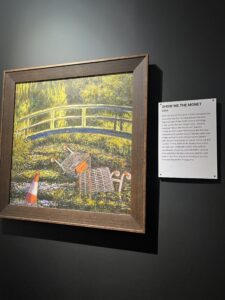On Saturday, 9/21, I made a trip to Manhattan to visit the Banksy Museum. I had ordered my ticket online prior to arriving, which was convenient. However, I do not think I would have had to wait very long to purchase a ticket in person because there was no line, and there were only a few people in the museum at the time. These people were different from one another, some were younger couples, some were older, and there were a few small families walking around. I thought it was interesting that Banksy’s art attracted various different demographics.
Attempting to ignore the amount of pieces that were displayed on artificial walls (to me, this felt disingenuous), the images themselves were quite intriguing to me.
- Show Me The Monet, 2005

This piece stood out to me because I remember seeing original Monet works at the MoMA when I visited for this class. This modern take on the piece in which Banksy adds items such as shopping carts and traffic cones to the landscape. These items look out of place in the context of the piece, which seems to be intentional. I think that this can be interpreted as commentary on the rise of the capitalistic nature of the world, as shopping carts are essentially polluting this image of a natural environment. The parody-like disposition of this painting is exemplary of a common theme among Banksy’s art, which is that it goes against the anticipated. He uses his craft to call out issues in the world that he deems important to spread awareness about. This can be considered a sign of non-conformity, which is both prominent in his ideology and his art.
2. Game Changer, 2020

This piece piqued my interest due to its meaning. This art is a tribute to healthcare workers, aligning them with figures of superheroes. While this can be considered a general sentiment, in context it is more meaningful when the year it was made is taken into consideration. This work appeared in 2020, amid the peak of the global pandemic. Nurses and healthcare workers were risking their lives to treat others and worked to minimize the spread of the virus. Creating this work dedicated to the sometimes unacknowledged challenges that these workers faced signifies how Banksy not only uses his abilities to draw attention to negative aspects of the world that need attention, but also utilities his art to uplift the under-appreciated.
3. Festival (Destroy Capitalism), 2006

The message of this piece continues to affirm the anti-capitalist beliefs that are conveyed in other art that Banksy has created. However, the metaphor of a merchandise stand stood out to me because when I reached the end of the museum, I was led into a gift shop. I found various different items bearing images of Banksy’s most famous and popular pieces, all available to purchase. I am aware that this museum is unaffiliated with him, but it provokes me to wonder why he would not stop the operation. I believe this may have been intentional to give further meaning to pieces such as this one, as even Banksy’s most anti-capitalist works have been commodified in some shape or form by this museum. Whether they are merely being displayed, or they are literally being sold in the gift shop, they are being commercialized. This solidifies the idea that capitalism is still on the rise and that this is a current matter.
In conclusion, the Banksy museum allowed me to explore the various topics that Banksy used his art to discuss and raise awareness of, but its existence may be built upon irony.


